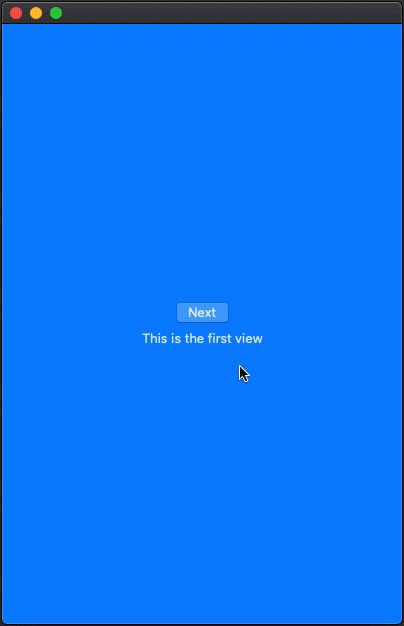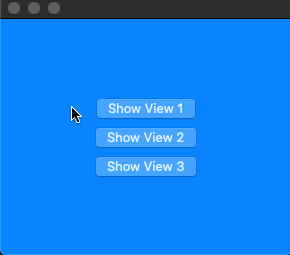macOS SwiftUI Navigation for a Single View
Here is a simple demo of possible approach for custom navigation-like solution. Tested with Xcode 11.4 / macOS 10.15.4

Note: background colors are used for better visibility.
struct ContentView: View {
@State private var show = false
var body: some View {
VStack{
if !show {
RootView(show: $show)
.frame(maxWidth: .infinity, maxHeight: .infinity)
.background(Color.blue)
.transition(AnyTransition.move(edge: .leading)).animation(.default)
}
if show {
NextView(show: $show)
.frame(maxWidth: .infinity, maxHeight: .infinity)
.background(Color.green)
.transition(AnyTransition.move(edge: .trailing)).animation(.default)
}
}
}
}
struct RootView: View {
@Binding var show: Bool
var body: some View {
VStack{
Button("Next") { self.show = true }
Text("This is the first view")
}
}
}
struct NextView: View {
@Binding var show: Bool
var body: some View {
VStack{
Button("Back") { self.show = false }
Text("This is the second view")
}
}
}
I've expanded upon Asperi's great suggestion and created a generic, reusable StackNavigationView for macOS (or even iOS, if you want). Some highlights:
- It supports any number of subviews (in any layout).
- It automatically adds a 'Back' button for each subview (just text for now, but you can swap in an icon if using macOS 11+).

Swift v5.2:
struct StackNavigationView<RootContent, SubviewContent>: View where RootContent: View, SubviewContent: View {
@Binding var currentSubviewIndex: Int
@Binding var showingSubview: Bool
let subviewByIndex: (Int) -> SubviewContent
let rootView: () -> RootContent
var body: some View {
VStack {
VStack{
if !showingSubview { // Root view
rootView()
.frame(maxWidth: .infinity, maxHeight: .infinity)
.transition(AnyTransition.move(edge: .leading)).animation(.default)
}
if showingSubview { // Correct subview for current index
StackNavigationSubview(isVisible: self.$showingSubview) {
self.subviewByIndex(self.currentSubviewIndex)
}
.frame(maxWidth: .infinity, maxHeight: .infinity)
.transition(AnyTransition.move(edge: .trailing)).animation(.default)
}
}
}
}
init(currentSubviewIndex: Binding<Int>, showingSubview: Binding<Bool>, @ViewBuilder subviewByIndex: @escaping (Int) -> SubviewContent, @ViewBuilder rootView: @escaping () -> RootContent) {
self._currentSubviewIndex = currentSubviewIndex
self._showingSubview = showingSubview
self.subviewByIndex = subviewByIndex
self.rootView = rootView
}
private struct StackNavigationSubview<Content>: View where Content: View {
@Binding var isVisible: Bool
let contentView: () -> Content
var body: some View {
VStack {
HStack { // Back button
Button(action: {
self.isVisible = false
}) {
Text("< Back")
}.buttonStyle(BorderlessButtonStyle())
Spacer()
}
.padding(.horizontal).padding(.vertical, 4)
contentView() // Main view content
}
}
}
}
More info on @ViewBuilder and generics used can be found here.
Here's a basic example of it in use. The parent view tracks current selection and display status (using @State), allowing anything inside its subviews to trigger state changes.
struct ExampleView: View {
@State private var currentSubviewIndex = 0
@State private var showingSubview = false
var body: some View {
StackNavigationView(
currentSubviewIndex: self.$currentSubviewIndex,
showingSubview: self.$showingSubview,
subviewByIndex: { index in
self.subView(forIndex: index)
}
) {
VStack {
Button(action: { self.showSubview(withIndex: 0) }) {
Text("Show View 1")
}
Button(action: { self.showSubview(withIndex: 1) }) {
Text("Show View 2")
}
Button(action: { self.showSubview(withIndex: 2) }) {
Text("Show View 3")
}
}
.frame(maxWidth: .infinity, maxHeight: .infinity)
.background(Color.blue)
}
}
private func subView(forIndex index: Int) -> AnyView {
switch index {
case 0: return AnyView(Text("I'm View One").frame(maxWidth: .infinity, maxHeight: .infinity).background(Color.green))
case 1: return AnyView(Text("I'm View Two").frame(maxWidth: .infinity, maxHeight: .infinity).background(Color.yellow))
case 2: return AnyView(VStack {
Text("And I'm...")
Text("View Three")
}.frame(maxWidth: .infinity, maxHeight: .infinity).background(Color.orange))
default: return AnyView(Text("Inavlid Selection").frame(maxWidth: .infinity, maxHeight: .infinity).background(Color.red))
}
}
private func showSubview(withIndex index: Int) {
currentSubviewIndex = index
showingSubview = true
}
}
Note: Generics like this require all subviews to be of the same type. If that's not so, you can wrap them in AnyView, like I've done here. The AnyView wrapper isn't required if you're using a consistent type for all subviews (the root view’s type doesn’t need to match).